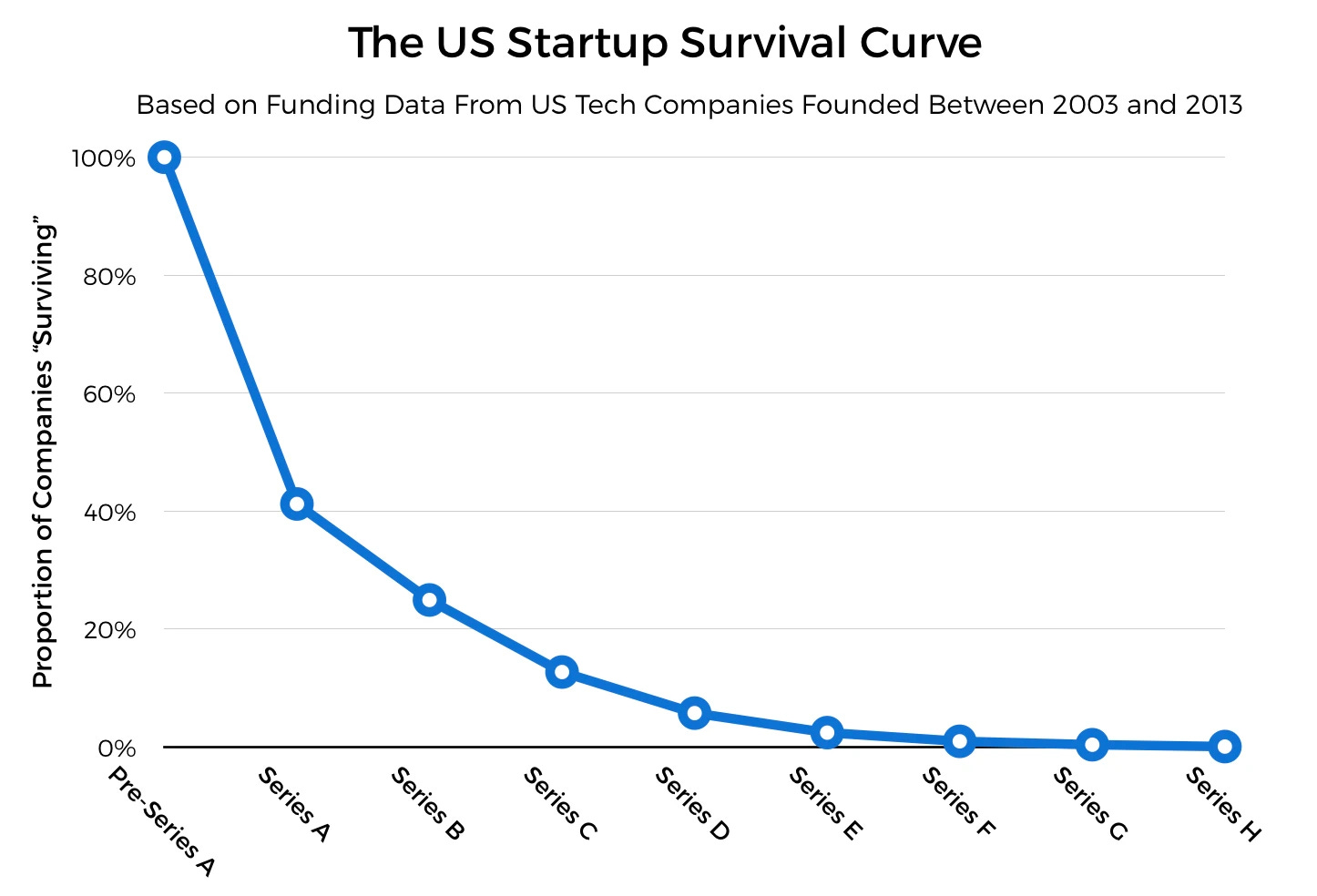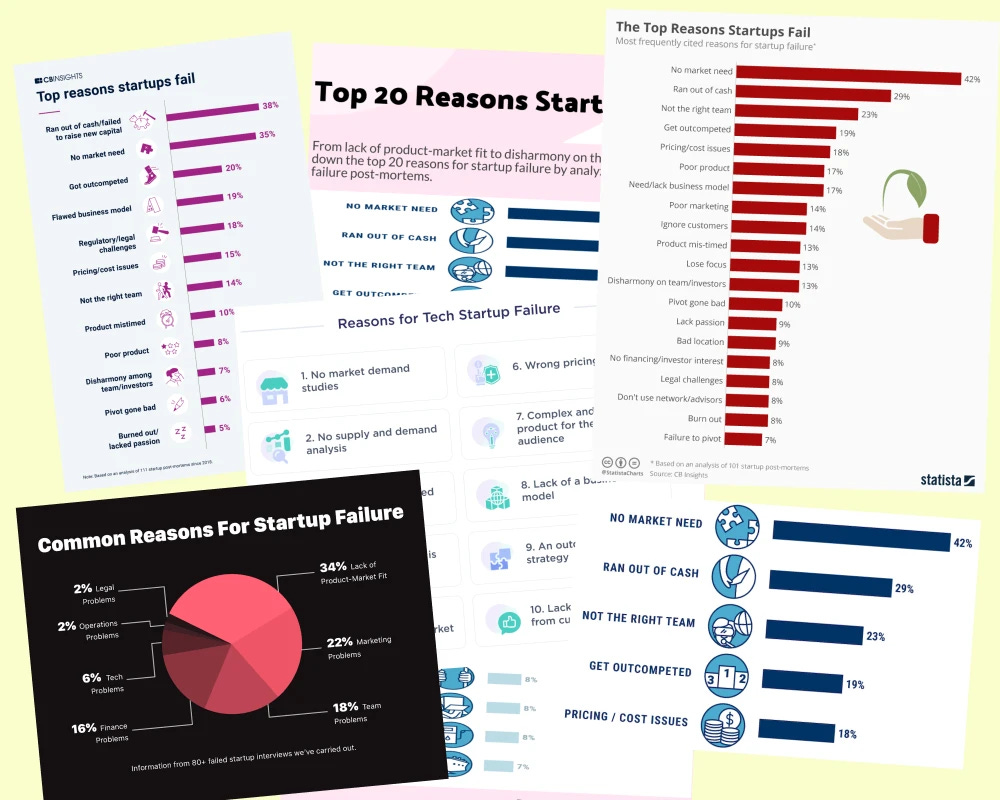What if I told you…
...There is a multi-trillion-dollar global economy that has the potential to be significantly larger if only about 60% of the companies within it didn't fail prematurely.
Additionally, of the hundreds of billions invested in companies in this economy, approximately three quarters are either completely lost or generate minimal profits.
This situation seems to align with the conditions that make a market ripe for disruption by Silicon Valley startups and investors.
However, the trillion-dollar economy in question is not a hot new sector of AI, Autonomous Vehicles or Marketplaces, but actually the global startup ecosystem itself.
Ironically, the need that fulfills all the criteria of the startup formula (solving a problem that many people care about) is in fact the meta-problem faced by startups themselves - the problem of achieving scalable traction.
A Trillion-Dollar problem is hiding in plain sight
Analysts estimate the total value of the global startup economy to be somewhere between $2.3 trillion and $3.8 trillion. Annually, somewhere between $300 billion and $600 billion is invested, but a significant portion of that capital, between 60% and 90%, is either lost entirely or returned unprofitably.
As you might expect, these losses are not evenly distributed. As startups progress to later stages and mature, they become less risky, and most of the losses occur in the early stages.
What might surprise you is the steepness of the failure rate curve and how unevenly distributed the failures are.
Source: TechCrunch
By observing the startup failure rate by stage, we can see the most significant drop in survival between seed and Series A.
Furthermore, the time taken for a company to progress from Seed to Series A has increased by almost 80% in less than a decade, from 14 months in 2014 to 25 months in 2023, creating a “Pile-up” of seed funded startups that are struggling to raise a Series A.
So what is happening here?
While the macro-economic climate certainly plays a significant role, if you speak to any founder or investor in this stage, they will tell you that "it's all about Traction."
With traction being a prerequisite for a software company raising an A round (or a hardware or deep-tech company raising a B round), it can be inferred that nearly 80% of startups fail to achieve investible traction.
Just imagine how much larger the multi-trillion dollar startup economy could be if approximately 80% of startups didn't fail before ever achieving traction!
The Traction Blindspot
A lot has been written about the various reasons why startups may fail. Popular articles often mention numerous factors, but a few common themes emerge, including lack of product-market fit and failure to raise sufficient capital.
However, if we take a step back and categorize these causes more broadly, grouping factors such as product-market fit, revenue, and fundraising together, we can see that the overarching theme of traction that surpasses all others.
The Traction Gap
If the challenge of traction is such a significant obstacle for a valuable sector of our economy, how has it been able to persist with such a high rate of failure for such a long time?
I believe it is because there are clear gaps in three dimensions.
A gap in motivation
Most founders start a company with either a problem or a technical insight. However, very few of them have a passion for traction, and certainly none have dedicated education in it.A gap in methodologies
Before gaining traction, we have methodologies like Lean Startup and Customer Discovery that demystify and systematize the process of creating a great product. After gaining traction, we have both new practices in Growth Hacking and the legacy experience of marketing to scale a traction channel that already works. However, there is no such methodology for the gap in between, in which scalable traction needs to be found.A gap in solution providers
We have numerous product agencies and experts for product creation, and even more agencies to launch products and scale marketing channels once traction is validated.
But as a CMO who has worked in the tech startup industry for the past 8 years, specifically in this phase, I have noticed a lack of clear methodology, experts, or suppliers to seek answers and validation for some of the most crucial questions that businesses face at this time:
Do I truly have product-market fit? How can I determine this? What does it even mean?
Have I correctly identified the best audience as my early adopters? How can I effectively reach them in a profitable manner?
How can I not only create a "launch," but also establish a scalable growth engine that generates repeatable revenue and is deserving of investment?
When we put all of this together, we find ourselves in an absurd situation where the most deadly challenge facing every single startup lacks any counterbalance in terms of skills, education, or supply.
To me, this just seems completely broken.
No Worthy Innovation Should Die On The Battlefield Of Traction
Not every startup deserves to succeed. It is natural and correct that some significant percentage of startups should be wound down early.
In fact, one of the original intentions of Eric Ries & Steve Blank’s work was to help founders determine early on whether their big idea was not going to be successful. While it may be difficult to hear, it is better to learn this early, rather than investing years of your career and life savings into it.
However, if a startup does have a great product that the market wants, and they have a strong team to meet the demand, they should not fail simply because they struggle to resolve their traction challenges. That much should be solvable.
Introducing Traction Design
In response to this challenge, I propose a new methodology and practice to fill the gap left by existing methodologies and service providers.
It shall be called "Traction Design."
Similar to the Lean Startup approach, the objective is to transform typically haphazard processes and anecdotal advice into something concrete, dependable, and reproducible.
As Eric Ries stated:
"Startup success can be engineered by following the process, which means it can be learned, which means it can be taught."
I apply the same belief to achieving startup traction.
The Founding Principles Of Traction Design Are:
Traction is Achieved By Design.
Traction is not discovered through haphazard trial-and-error. It is deliberately engineered through proven frameworks and reliable processesTraction is a First-Class Priority
Traction is equally as important as the product and team. It should be resourced and prioritized as suchProduct-Market Fit Is The Foundation Of Traction
Product-Market Fit is a tangible and measurable milestone, rather than an ambiguous state. It can and should be validated through quantifiable means.Not all Early Adopters Are Optimal
The typical understanding of an early adopter overlooks much of the value and opportunity that comes with identifying and targeting a specific niche and market insertion point from the beginning.Not All Traction Is Investible
Investors do not invest in early adopter traction alone. In order to attract VC investment, startups must demonstrate their ability to acquire later-stage customers profitably and at scale.Flywheels Beat Fireworks.
Traction Design is not about launches or short term campaigns. It is about creating flywheels of growth that pay back with revenue every day, not one-time launches or campaigns that draw interest like a firework display then fizzle out shortly afterwards.Invalidation Is Valuable
Traction Design aims to validate growth and distribution hypotheses before scaling, but also recognizes that invalidating assumptions through experimentation is equally valuable. Only by humbly discovering early on what will not work, can we release and reallocate resources towards more promising endeavors.
Traction Design Is A Distinctly New Specialism
Traction design is a broad skillset that is tightly focused on a narrow problem space. It combines strategy, research, storytelling, growth strategy, financial modeling, forecasting and more.
As a new practice, Traction Design overlaps with, but is quite distinct from:
Marketing
Unlike typical marketing functions Traction Design prioritizes repeatable, sustainable growth models over headline-grabbing campaigns and launchesProduct
As part of product-market fit, Traction Designers collaborate with the product team (or founder) to ensure the product has sharp superpowers targeted at the market needsGrowth Hacking & Performance Marketing
We share a vision for scalable growth and an approach based on metrics and experimentation. However, Traction Design focusses on the design and validation of scalable growth models, before handing over to growth teams for incremental scalingGo-To-Market
We share an interest in analyzing the right channels and messages to enter the market with, but we don’t stop at the initial launch, or at the first market insertion point.
Join Me And Achieve Traction By Design
I believe that startups are the most powerful force for innovation and progress in our modern society. However, there is currently an excessive amount of premature death and unnecessary failure in startups.
More tragic than the trillions of dollars of unrealized value is the missed opportunity to create countless innovations and experiences that could improve the lives of people worldwide. Worse still, the hopes and dreams of startup founders and employees who invest their careers and more into making these dreams a reality that get wasted in the process.
My goal is to create the company that becomes the go-to source of help for companies seeking traction. However, I am humbly open-minded about what type of company most needs this help, and what type of company they need me to create.
If you share a similar motivation or are simply interested in learning more, I invite you to join me by subscribing to this free publication.
You can also find and DM via LinkedIn and Twitter.
If you are interested in having a direct conversation and learning more about consulting, feel free to contact me for a free chat and consultation.
Thank you for reading.
(This article first appeared at https://www.tractiondesignco.com/blog/welcome-to-traction-design )







